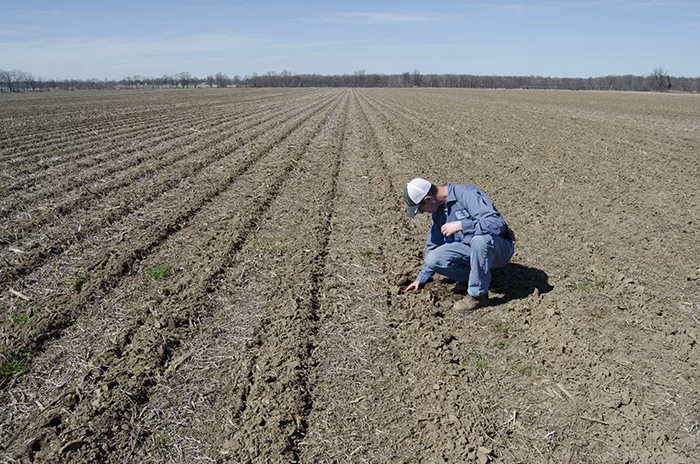From proper fertilizer placement and depth, to the right row unit setup, manufacturers offer considerations for strip-tillers to mull over before planting.
For some strip-tillers, extremely wet conditions last fall may have prevented them from building strips soon after harvest.
While spring strip-till is commonplace for some growers, those who build strips exclusively in the fall, or have a two-pass system, may have to adjust their plans.
Strip-Till Strategies editors caught up with several strip-till manufacturers to solicit advice for novice and veteran spring strip-tillers. Here is what they had to share.
1. Plan Your Fertility Program Accordingly
Fertility plans may change from season to season, but in light of a wet fall, farmers may want revisit their strategy.
“For full spring application you should watch your fertilizer rates,” says Nick Jensen, co-owner and Chief Marketing Officer of Thurston Mfg.,“It may be better to make a partial nitrogen application, then come back with the planter and sidedress the second half to spoon feed the crop and avoid getting it too hot right under the seed zone.”
Looking at samples can help farmers gauge their specific needs.
“You should preplan your fertility program based on soil samples or mapping programs to ensure desired rates and formulas for optimal yield potential,” says Justin Troudt, sales manager of Orthman Mfg.
Following the advice of an agronomist is another good way to get some targeted advice on rates.
“You have to figure out how much fertilizer you need to put on,” says Joe Bassett, president of Dawn Equipment. “There are a lot of fertilizer questions because farmers want to apply a higher rate, but they might not feel comfortable doing so because of burn. Consulting your agronomist can help a lot.”
2. Be Wary of Fertilizer Placement
Going into the spring with a good fertility plan is a start, but in order to apply fertilizer effectively, placement is also important.
“Don’t get your nitrogen levels too high and don’t get your salty fertilizer levels too high in the zone,” warns Kevin Kuehn, product support manager of Environmental Tillage Systems. “If you do have to apply those saltier fertilizers, make sure you put it down at least 5 inches, and get it out of the seed zone.”
Placement may be especially challenging with fertilizers that are tricky to handle, such as urea.
“The only major case of anyone burning their crop with fertilizer in the spring that we’ve had is with urea. Be cautious with it,” says Bassett. “It’s a lighter product that can be harder to get mixed and place properly.”
3. Calibrate Application Systems
Without properly calibrated equipment, planning a precise fertilization program may be all for naught.
“I suggest calibrating your drive fertilizer system and calibrating your liquid systems before spring,” says Kuehn. “You have to make sure what you anticipated putting on is what you’re actually putting on.”
4. Use Shanks Carefully
In the spring, farmers should keep a close eye on the effect their shanks are having on the soil. “When you’re using a shank in the spring, just make sure to use a less aggressive knife or point than you would in the fall,” says Jensen. “You still want some of that explosion, but not so much that the basket can’t come up afterward to take some of the air pockets out.”
Some situations might call for a shank run at a good depth, but it’s up to the farmer to know their soil types.
“Some guys are afraid of the shank in spring, but we’ve got guys in Kentucky running deep,” says Lyn Rosenboom of LandLuvr. “For some soils it might be the wrong thing, but I don’t think that a good shank is detrimental. Everyone has to know their soil.”
On the other hand, in some locations or times of season it might be best to remove the shank entirely in favor of running just coulters. The way to be sure, though, is by pulling out a shovel and finding out first hand.
“You have to adjust to conditions,” says George Mayo, sales manager of Bigham Bros. “If it’s getting too late and we are just ripping the slot, we’ll just run our unit without a ripper shank. I’d build a strip at full speed with the shank, take a trenching shovel and dig it out to see what kind of work you’re doing before deciding.”
5. Service, Set Up Equipment in Advance
In early spring, time is rarely on the farmer’s side, which is why it pays to be ready for ideal conditions when they arrive.
“Make sure your machine is serviced before spring,” says Kuehn. “You’ll want to make sure all the grease points are good to go, and look for frame crack and things like that.”
Being ready to hit the fields means running through all the service points, but it also means having the row units adjusted.
“Make sure you have your equipment set for your conditions in the spring,” says Derek Allensworth, sales manager of Yetter Mfg. “That might mean operating depth, levelness of the toolbar or setting the attachment that you are running in the spring for the placement of fertilizer.”
6. Make Sure Software is Updated
Updating software is an easy task to forget while getting all the larger equipment tuned up, but software glitches can stop a farmer just as fast as faulty equipment. Make sure the software on your GPS and your product control monitors are up with the current updates and standards, says Kuehn.
“The first thing a tech will ask you when you have a problem in the field is what version of the software you have. Having the most recent updates saves time,” he says.
7. Use a Basket Attachment
Some farmers who build strips in the fall do so without a basket, but if they’re forced to strip-till in the spring instead, they may have to change their approach.
“You’ll want to have a rolling basket in the spring,” says Jensen. “A lot of guys will run without one in the fall and say that the freeze/thaw cycle will take care of the strip and mellow it out. You’ll need a basket in the spring to push the berm down, take the air pockets out and crumble the soil.”
8. Start Early, But Not Too Early
It’s important to get to work early so there is enough time to plant, but heading out too early, especially in wet conditions, can cause problems.
“If you walk out there, dig down and pull out a big mud ball, it’s probably too early,” says Allensworth. “You want see a little of the soil being able to crumble — that should be your go gauge.”
Timing is also important when it comes to how closely the planter should follow the row unit, but again, the best barometer for this is the soil type.
“With some of the clay soils like in western Ohio, you won’t want too much time between strip-tilling and planting,” says Bassett. “You need to get back out there and get it planted quickly, because it can turn to bricks on you if it’s left for too long. Typically people are following the planter within a single day.”
9. Adjust Residue Management
Residue management is a bit different after the trash has had a chance to decompose during winter. Taking notice of this may help farmers adjust their strategy and build better strips.
“If you’re strip-tilling in the spring instead of the fall, you’ll have some residue breakdown because you’re not going right after the combine,” says Jensen. “You can usually set your residue manager a little less aggressively than you might normally. This will prevent that residue manager from digging too much, and if you have a heavy rain you won’t end up with divots.”
10. Look Closely at Depth
Paying close attention to depth is another consideration dependent on a farmer’s location.
“I’d say to run shallower than you would normally,” says Bassett. “We usually strip-till in the spring anyway, and it’s just a fact of life for us in Illinois. Whether you are 2-3 inches in the ground, but you don’t even necessarily have to get that deep.”
For parts of the country where fall strip-till is the norm, stripping deeper in the spring is equally ill advised.
“In Minnesota we don’t have a lot of spring tillage because of what happens to the soil,” says Wayne Buck, sales manager of Hiniker. “If you leave a void from a strip-till shank that’s 7 inches deep and drop a seed in the bottom of that, it takes a long time to come up — it’s not pretty. One of the major advantages with strip-till from my perspective is emergence. I wouldn’t want to jeopardize that by going too deep in spring.”







